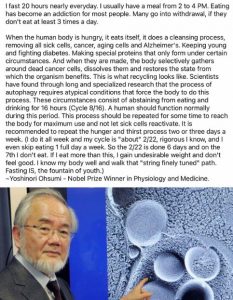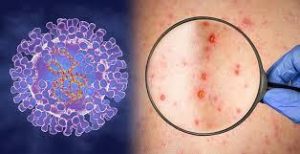
The Value Of Fasting

Hair Restore Formula
I saw an absolutely horrible, painfully cringeworthy sales pitch video for a hair loss formula. Here is the link so if you would like to try to product you can https://www.rescuehair911.com/rh911jsghv2/video.php or if you’d like to concoct a version of it for yourself, here is the list of ingredients:
Saw Palmetto
Pygeum Bark Extract
Reishi
Plant Sterol Complex
Pumpkin Seed Powder
Vitamin E
Vitamin B6
Cats Claw
Zinc
Copper
Broccoli Leaf
Selenium
Red Raspberry
Shitake
Graviola
Green Tea
Maitake
Stinging Nettle
Tomato Powder
I do not know how effective it is, I have not tried it myself. (Another $70 a month, for vanity – no thanks.) I have all bar one of these ingredients in my NutriBlast and have not noticed an increase in my hair!
If you try it and it works for you, please let me know!
Grandfathers vs Their Woke Offspring

JP kicks another goal.
https://odysee.com/grandfathers-vs-their-woke-offspring:4?r=6tVzDwNvHeSiJPZi8Tjexaia9ESSsULT
Minerals Essential for Optimal Thyroid Function
1.Iodine – T3 has 3 iodine molecules; T4 has 4. So it’s safe to say that the thyroid can’t function without iodine. T4 or (thyroxine) is 68 percent iodine by weight, and T3 (triiodothyronine) is 58 percent.
2.Selenium – A necessary cofactor in the production of thyroxine (T4), It also converts T4 to the more active form, T3. A total 11 selenium-dependent enzymes have been identified as necessary for thyroid function and thyroid hormone production. If you take iodine without selenium, you can cause selenium deficiency. If you take selenium without iodine, you can cause iodine deficiency.
3.Zinc – Required for the synthesis of thyroid hormones. Zinc deficiency can result in hypothyroidism. Thyroid hormones are essential for the absorption of zinc. The hair loss attributed to hypothyroidism may not improve with thyroid hormone replacement unless zinc supplements are added.
4.Molybdenum – Molybdenum-dependent enzymes function in the oxidative system of thyrocytes (thyroid epithelial cells). They also play an important role in T3 (thyroglobulin) release from the thyroid gland. Molybdenum also helps nitrogen metabolism.
5.Boron – Helps the conversion of the storage form of thyroid hormone, T4, to T3, the active form.
6.Copper – Plays an important role in the metabolism of the amino acid tyrosine, which is a precursor to T4 (thyroxine).
7.Chromium – Enhances insulin activity playing a major role in the regulation of insulin release and its effects on carbohydrate, protein and lipid metabolism. Conversion of T4 to T3 is influenced by insulin, so in a roundabout way, chromium helps this conversion. Chromium also assists in metabolism of carbohydrates.
8.Manganese – Required to transport the hormone thyroxine into our cells. Manganese also helps bones, connective tissues, and fat/carbohydrate metabolism.
9.Magnesium – Calcium and magnesium must be balanced in the body to ensure proper thyroid function. If there is too much calcium, thyroid hormones can become diminished. Magnesium is the regulator of calcium absorption and utilization.
If you would like a mineral supplement to ensure your intake is adequate, check this out: https://fulvicminerals.com.au/
Georgia Guidestones

Inconvenient truth for globalists: Arctic ice at 30-year high

The World Economic Forum and the globalist movement it helps lead have used the “climate crisis” and the COVID-19 pandemic as pretexts for measures to redistribute the wealth of nations.
But this week, as WEF convenes is annual conference in Davos, Switzerland, the Arctic sea ice expanse so far this month is at a 30-year high, according to data from intergovernmental European Organization for the Exploitation of Meteorological Satellites, points out climate-change skeptic Tony Heller.
EUMETSAT, as the organization is known, was created through an international convention signed by 30 European nations.
The extent of Arctic ice during the warmer months long has been a metric for climate-change alarmists. In 2007, Al Gore began warning the world that scientists were predicting that by 2013, the Arctic would be ice-free during the summer.
Last September, Heller noted the Arctic Ocean had gained a record amount of sea ice for that time of year.
“Most years the Arctic loses ice, but this year ice extent has increased” more than 77,000 square miles, he wrote on Twitter, adding the news likely would not be reported by CNN, BBC News or the New York Times.
Meanwhile, the sea melt last summer was the lowest in 15 years, and the expanse of Antarctic sea was well above average.
https://www.wnd.com/2022/05/inconvenient-truth-globalists-arctic-ice-30-year-high/
Create Happiness

Why Am I So Bad At Relationships?

Monkey Pox

I received this in a newsletter from a supplier and thought it worth sharing.
Again panic, again worry. With first news of monkeypox cases in the US, Europe, Canada, I feel like a call center employee. I keep getting calls from patients who are obviously extremely worried, asking me a lot of questions: What is monkeypox? How is it transmitted? How dangerous is this disease? How to recognize and treat it? Is the world facing a new epidemic?
For my patients, but also for all readers, I will answer each of these questions one by one, in order to bring more clarity and to calm the spirits as much as possible.
What is monkeypox?
Monkeypox is a rare disease caused by the monkeypox virus, is structurally related to the smallpox virus, and causes a similar but usually milder disease.
Monkeypox, like smallpox, belongs to the group of orthopoxviruses. Despite their name, monkeys are not reservoirs of monkeypox virus. Although the reservoir of the disease is unknown, the main suspects are small rodents (such as squirrels) from the rainforests of Africa, mostly found in West and Central Africa.
How is it transmitted?
Monkeypox is likely transmitted from animals through contact with bodily fluids, including droplets of saliva or nasal secretion, or contact with wound exudate. Person-to-person transmission is inefficient, and it is believed that infection occurs mainly by airborne droplets through prolonged close contact. The overall re-infection rate after contact with a known source is 3%, and rates up to 50% have been reported in people living with a person infected with monkeypox.
How dangerous is this disease?
In most cases, the incubation period lasts from 6 to 16 days, but it can last up to 21 days. The infected person develops a rash that can be painful and itchy. As a rule, the disease proceeds in a fairly mild form and goes away on its own in two to three weeks. The mortality rate for monkeypox outbreaks ranges from 1% to 10%. Most deaths occur in younger age groups.
How to recognize and treat it?
Monkeypox is not as contagious as smallpox, but can cause more severe illness in immunocompromised people. It manifests as a pseudoflu syndrome with fever, headache, muscle aches, bone pain, and extreme fatigue.
A few days after the appearance of these signs, redness begins to appear on the skin, after which it develops like lesions of smallpox or chickenpox. So the redness turns into blisters, which then turn into crusts.
One of the characteristics that distinguishes monkeypox from smallpox is swollen lymph nodes.
The evolution of the disease is about 2-3 weeks and has no specific treatment. As a prophylaxis, the smallpox vaccine also partially prevents the disease.
The treatment consists in the administration of vitamins, symptomatic anti-inflammatory drugs. It has been found that people, even if they get the disease, if they are vaccinated against smallpox, they have mild forms of the disease.
Is the world facing a new epidemic?
There is a reason for optimism: the fact is that it is quite difficult to catch monkeypox. To do this, you need to communicate closely with the inffected person for a long time. So, we should not expect a “covid” scenario. That is, to put it mildly, this is not the same as fighting the coronavirus, which can be contracted even through ventilation. There is, of course, no such risk here.
But we shouldn’t relax too much either. The fact is that monkeypox still does not have zero mortality: the larger the outbreak, the higher the mortality.
I hope I have answered at least some of the questions that concern you the most. My advice is to stay calm and not forget about hygiene rules. It may sound trivial, but experts say that common household disinfectants can kill the monkeypox virus.
Stay healthy!
